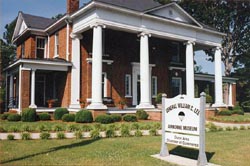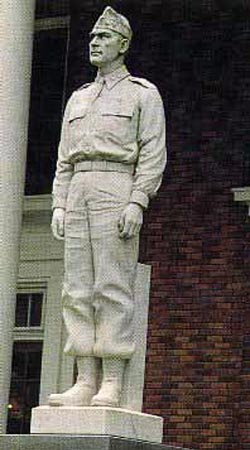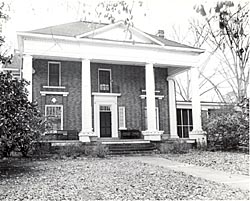
The General William C. Lee House in Dunn, North Carolina, is named for the internationally-known aviator who lived there for 13 years. The home was constructed, however, about 1915 by Jefferson Davis Barnes, a prominent Dunn businessman and one of the early residents of the Harnett County town. William C. Lee (1895-1948) was born in Dunn and was the fifth of Eldridge and Emma Jane Lee's seven children. William attended both Wake Forest and North Carolina State colleges and graduated from the latter in 1917. With training in the R.O.T.C. program at N.C. State, Lee decided upon a career in military service. Commissioned as a second lieutenant, Lee began his active military career at age 22. Following his attendance at Infantry School, Lee entered World War I with the American Expeditionary Army in France where he served as platoon leader and company commander. After the war he continued his military training in the tank warfare schools at Fort Meade, Maryland, and Versailles, France. In the 1930s, Lee attended Command and general Staff School and was promoted to major. On one of two extended European tours, he observed the German parachute and glider operations which he believed would be an invaluable asset to the U.S. Army's military development. Returning home he was ordered to the Office of the Chief of Infantry in Washington, D.C., which gave him the opportunity to promote his ideas.

Major Lee encountered stiff opposition from the military high command until President Franklin D. Roosevelt took special interest in the concept of an airborne unit and ordered the creation of such a division. A parachute school was established at Fort Benning, Georgia, with Lee as commander. Under his guidance, improvements were made to the German system and when World War II broke out, the airborne unit stood ready to play a vital role in the ultimate victory. By the time the United States entered the war, Lee had been promoted to general and placed in command of the 101st Division. From his division headquarters in Reading, England, General Lee directed America's airborne troops. As a military strategist and advisor to General Dwight D. Eisenhower, Lee wrote the airborne doctrine and devised the tactical plans employed in the D-Day invasion of the European Continent. Unfortunately, Lee suffered a heart ailment that forced him to return to the United States before the invasion began. He watched the successful implementation of his plans from his home in Dunn.
General Lee was in active military service when his wife, Dava Johnson Lee, whom he married in 1918, bought this house on West Divine Street in 1935. Upon returning here Lee, although officially retired, continued in the role of advisor and consultant. Numerous prominent figures visited his Dunn home, including General F.A.M. Browning, chief of Great Britain's airborne forces and later treasurer to Prince Phillip with offices in Buckingham Palace, who spent several weekends with Lee during his American tour. General Lee died on June 25, 1948. Two days later, the grandest funeral ever held in Dunn honored "the father of America's airborne troops." Surrounded by state and U.S. Army dignitaries and thousands paying homage, Lee was laid to rest in Greenwood Cemetery.

The Lee House is an imposing example of early 20th-century Neo-Classical Revival residential architecture. Built in 1915, the 4,5000-square foot home has a rough textured, variegated brick veneer and consists of a two-story, double pile main section with one-story rear wings. Monumental Tuscan columns support the deep but simple entablature of the full-façade hipped roof porch.
Visit the National Park Service Travel American Aviation to learn more about Aviation related Historic Sites.
Last updated: September 3, 2017






